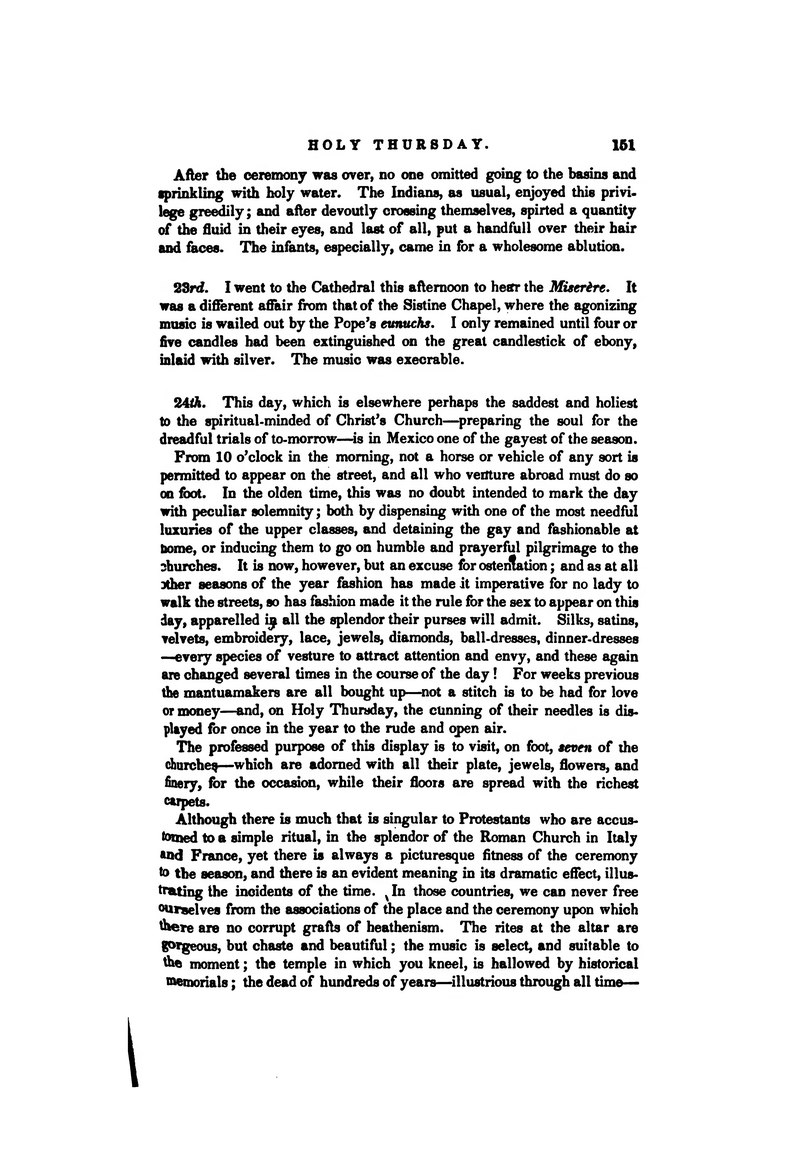After the ceremony was over, no one omitted going to the basins and sprinkling with holy water. The Indians, as usual, enjoyed this privilege greedily; and after devoutly crossing themselves, spirted a quantity of the fluid in their eyes, and last of all, put a handfull over their hair and faces. The infants, especially, came in for a wholesome ablution.
23rd. I went to the Cathedral this afternoon to hear the Miserére. It was a different affair from that of the Sistine Chapel, where the agonizing music is wailed out by the Pope's eunuchs. I only remained until four or five candles had been extinguished on the great candlestick of ebony, inlaid with silver. The music was execrable.
24th. This day, which is elsewhere perhaps the saddest and holiest to the spiritual-minded of Christ's Church—preparing the soul for the dreadful trials of to-morrow—is in Mexico one of the gayest of the season. From 10 o'clock in the morning, not a horse or vehicle of any sort is permitted to appear on the street, and all who venture abroad must do so on foot. In the olden time, this was no doubt intended to mark the day with peculiar solemnity; both by dispensing with one of the most needful luxuries of the upper classes, and detaining the gay and fashionable at home, or inducing them to go on humble and prayerful pilgrimage to the churches. It is now, however, but an excuse for ostentation; and as at all other seasons of the year fashion has made it imperative for no lady to walk the streets, so has fashion made it the rule for the sex to appear on this day, apparelled in all the splendor their purses will admit. Silks, satins, velvets, embroidery, lace, jewels, diamonds, ball-dresses, dinner-dresses—every species of vesture to attract attention and envy, and these again are changed several times in the course of the day! For weeks previous the mantuamakers are all bought up—not a stitch is to be had for love or money—and, on Holy Thursday, the cunning of their needles is displayed for once in the year to the rude and open air.
The professed purpose of this display is to visit, on foot, seven of the churches—which are adorned with all their plate, jewels, flowers, and finery, for the occasion, while their floors are spread with the richest carpets.
Although there is much that is singular to Protestants who are accustomed to a simple ritual, in the splendor of the Roman Church in Italy and France, yet there is always a picturesque fitness of the ceremony to the season, and there is an evident meaning in its dramatic effect, illustrating the incidents of the time. In those countries, we can never free ourselves from the associations of the place and the ceremony upon which are no corrupt grafts of heathenism. The rites at the altar are gorgeous, but chaste and beautiful; the music is select, and suitable to the moment; the temple in which you kneel, is hallowed by historical memorials; the dead of hundreds of years—illustrious through all time—
